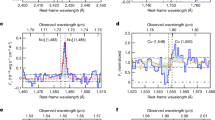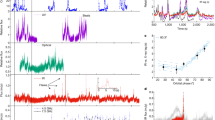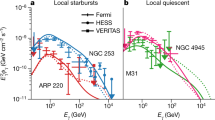Abstract
THE radio source at the centre of our Galaxy1, Sagittarius A* (Sgr A*), seems to be a low-luminosity version of active galactic nuclei—a massive black hole that is accreting gas from the surrounding region1,2. This idea is supported by observations of the gas and stars within 1 pc of Sgr A*, which appear to move under the influence of a large central mass1,3,4. A recent determination of the upper limit5,6 to the hard X-ray emission from the Galactic Centre has posed a problem for this picture, however, as the mass accretion rate implied by applying a standard accretion model to the X-ray data is far below that estimated from the observations of gas flows. Here we present a new model of accretion onto Sgr A*, in which most of the energy released is carried along with the gas and lost into the black hole of mass ∼7 x 105 solar masses, rather than appearing as radiation. The model fits the observed spectrum of Sgr A* from radio to hard X-ray wavelengths, and reconciles the low observed luminosity with a high mass-accretion rate.
This is a preview of subscription content, access via your institution
Access options
Subscribe to this journal
Receive 51 print issues and online access
$199.00 per year
only $3.90 per issue
Buy this article
- Purchase on Springer Link
- Instant access to full article PDF
Prices may be subject to local taxes which are calculated during checkout
Similar content being viewed by others
References
Genzel, R. & Townes, C. H. A. Rev. Astr. Astrophys. 25, 377–423 (1987).
Lynden-Bell, D. & Rees, M. Mon. Not. R. astr. Soc. 152, 461–475 (1971).
Lacy, J. H., Achtermann, J. M. & Serabyn, E. Astrophys. J. 380, L71–L74 (1991).
McGinn, J. T., Sellgren, K., Becklin, E. E. & Hall, D. N. B. Astrophys. J. 338, 824–840 (1989).
Goldwurm, A. et al. Nature 371, 589–591 (1994).
Grindlay, J. E. Nature 371, 561–562 (1994).
Falcke, H., Biermann, P. L., Duschl, W. J. & Mezger, P. G. Astr. Astrophys. 270, 102–106 (1993).
Frank, J., King, A. & Raine, D. Accretion Power in Astrophysics (Cambridge Univ. Press. 1992).
Falcke, H., Mannheim, K. & Biermann, P. L. Astr. Astrophys. 278, L1–L4 (1993).
Abramowicz, M., Czerny, B., Lasota, J. P. & Szuszkiewicz, E. Astrophys. J. 332, 646–658 (1988).
Honma, F., Matsumoto, R. & Kato, S. Publs astr. Soc. Japan 43, 147–168 (1991).
Narayan, R. & Popham, R. Nature 362, 820–822 (1993).
Popham, R., Narayan, R., Hartmann, L. & Kenyon, S. Astrophys. J. 415, L127–L130 (1993).
Narayan, R. & Yi, I. Astrophys. J. 428, L13–L16 (1994).
Narayan, R. & Yi, I. Astrophys. J. 444, 231–243 (1995).
Narayan, R. & Yi, I. Astrophys. J. (in the press).
Abramowicz, M., Chen, X., Kato, S., Lasota, J. P. & Regev, O. Astrophys. J. 438, L37–L40 (1995).
Rees, M. J., Begelman, M. C., Blandford, R. D. & Phinney, E. S. Nature 295, 17–21 (1982).
Shapiro, S. L., Lightman, A. P. & Eardley, D. M. Astrophys. J. 204, 187–199 (1976).
Melia, F. Astrophys. J. 387, L25–L28 (1992).
Shakura, N. I. & Sunyaev, R. A. Astr. Astrophys. 24, 337–355 (1973).
Melia, F. Astrophys. J. 426, 577–585 (1994).
Duschl, W. J. & Lesch, H. Astr. Astrophys. 286, 431–436 (1994).
Melia, F., Jokipii, J. R. & Narayanan, A. Astrophys. J. 395, L87–L90 (1992).
Rogers, A. E. E. et al. Astrophys. J. 434, L59–L62 (1994).
Backer, D. C. et al. Science 262, 1414–1416 (1993).
Zhao, J.-H., Ekers, R. D., Goss, W. M., Lo, K. Y. & Narayan, R. in The Center of the Galaxy (ed. Morris, M.) 535–538 (IAU Symp. No. 136, Kluwer, Dordrecht, 1989).
Begelman, M. C. & Chiueh, T. Astrophys. J. 332, 872–890 (1988).
Zylka, R., Mezger, P. G. & Lesch, H. Astr. Astrophys. 261, 119–129 (1992).
Zylka, R., Mezger, P. G., Ward-Thompson, D., Duschl, W. J. & Lesch, H. Astr. Astrophys. (in the press).
Eckart, A. et al. Nature 355, 526–529 (1992).
Rosa, M. R., Zinnecker, H., Moneti, A. & Melnick, J. Astr. Astrophys. 257, 515–522 (1991).
Pavlinskii, M. N., Grebenev, S. A. & Sunyaev, R. A. Soviet Astr. Lett. 18, 116–120 (1992).
Watson, M. G., Willingale, R., Grindlay, J. E. & Hertz, P. Astrophys. J. 250, 142–154 (1981).
Pavlinskii, M. N., Grebenev, S. A. & Sunyaev, R. A. Astrophys. J. 425, 110–121 (1994).
Predehl, P. & Trümper, J. Astr. Astrophys. 290, L29–L32 (1994).
Skinner, G. K. et al. Nature 330, 544–547 (1987).
Kawai, N. et al. Astrophys. J. 330, 130–141 (1988).
Skinner, G. K. in The Center of the Galaxy (ed. Morris, M.) 567–580 (IAU Symp. No. 136, Kluwer, Dordrecht, 1989).
Author information
Authors and Affiliations
Rights and permissions
About this article
Cite this article
Narayan, R., Yi, I. & Mahadevan, R. Explaining the spectrum of Sagittarius A* with a model of an accreting black hole. Nature 374, 623–625 (1995). https://doi.org/10.1038/374623a0
Received:
Accepted:
Issue Date:
DOI: https://doi.org/10.1038/374623a0
This article is cited by
-
Science with a Small Two-Band UV-Photometry Mission III: Active Galactic Nuclei and Nuclear Transients
Space Science Reviews (2024)
-
Black holes up close
Nature (2023)
-
Precessing jet nozzle connecting to a spinning black hole in M87
Nature (2023)
-
Observing black holes spin
Nature Astronomy (2019)
-
Testing general relativity with the Event Horizon Telescope
General Relativity and Gravitation (2019)
Comments
By submitting a comment you agree to abide by our Terms and Community Guidelines. If you find something abusive or that does not comply with our terms or guidelines please flag it as inappropriate.



